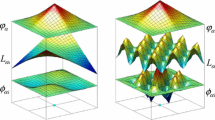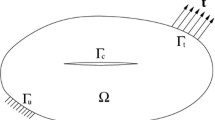Abstract
In this study, a gradient weighted extended finite element method (GW-XFEM) is presented for the analysis of fracture problems. For this method, the domain discretization is the same as the standard XFEM. However, the gradient field is constructed by considering the influences of the element itself and its adjacent elements. Based on the Shepard interpolation, the weighted strain filed can be obtained, which will be utilized to construct the discretized system equations. The validity of the presented method is fully investigated through several numerical examples. From these results, it is shown that compared with standard XFEM, the presented method can achieve much better accuracy, efficiency and higher convergence, when dealing with fracture analysis.
Similar content being viewed by others
References
Menouillard, T., Belytschko, T.: Dynamic fracture with meshfree enriched XFEM. Acta Mech. 213, 53–69 (2008)
Spieler, C., Kaestner, M., Goldmann, J., Brummund, J., Ulbricht, V.: XFEM modeling and homogenization of magnetoactive composites. Acta Mech. 224, 2453–2469 (2013)
Wu, L., Liu, P., Shi, C., Zhang, Z., Bui, T.Q., Jiao, D.: Edge-based smoothed extended finite element method for dynamic fracture analysis. Appl. Math. Model. 40, 8564–8579 (2016)
Areias, P., Rabczuk, T., Dias-da-Costa, D.: Element-wise fracture algorithm based on rotation of edges. Eng. Fract. Mech. 110, 113–137 (2013)
Bansal, M., Singh, I.V., Mishra, B.K., Sharma, K., Khan, I.A.: A stochastic XFEM model for the tensile strength prediction of heterogeneous graphite based on microstructural observations. J. Nucl. Mater. 487, 143–157 (2017)
Singh, S.K., Singh, I.V., Mishra, B.K., Bhardwaj, G., Bui, T.Q.: A simple, efficient and accurate Bézier extraction based T-spline XIGA for crack simulations. Theor. Appl. Fract. Mech. 88, 74–96 (2017)
Agathos, K., Chatzi, E., Bordas, S., Talaslidis, D.: A well-conditioned and optimally convergent XFEM for 3D linear elastic fracture. Int. J. Numer. Methods Eng. 9, 643–677 (2016)
Bordas, S., Duflot, M., Le, P.: A simple error estimator for extended finite elements. Commun. Numer. Methods Eng. 11, 961–971 (2008)
Belytschko, T., Black, T.: Elastic crack growth in finite elements with minimal remeshing. Int. J. Numer. Methods Eng. 45, 602–620 (1999)
Moes, N., Dolbow, J., Belytschko, T.: A finite element method for crack growth without remeshing. Int. J. Numer. Methods Eng. 46, 131–150 (1999)
Ghorashi, S.S., Valizadeh, N., Mohammadi, S., Rabczuk, T.: T-spline based XIGA for fracture analysis of orthotropic media. Comput. Struct. 147, 138–146 (2015)
Patil, R.U., Mishra, B.K., Singh, I.V.: A new multiscale XFEM for the elastic properties evaluation of heterogeneous materials. Int. J. Mech. Sci. 122, 277–287 (2017)
Wang, Z., Yu, T.T., Bui, T.Q., Ngoc, Anh T., Nguyen-Thi, H.L., Nguyen-Dinh, D., Duc-Hong, D.: Numerical modeling of 3-D inclusions and voids by a novel adaptive XFEM. Adv. Eng. Softw. 102, 105–122 (2016)
Feng, S.Z., Li, W.: An accurate and efficient algorithm for the simulation of fatigue crack growth based on XFEM and combined approximations. Appl. Math. Model. 55, 600–615 (2018)
Sutula, D., Kerfriden, P., Van Dam, T., Bordas, S.: Minimum energy multiple crack propagation. Part I: theory and state of the art review. Eng. Fract. Mech. 191, 205–224 (2017)
Sutula, D., Kerfriden, P., Van Dam, T., Bordas, S.: Minimum energy multiple crack propagation. Part-II: discrete solution with XFEM. Eng. Fract. Mech. 191, 225–256 (2017)
Sutula, D., Kerfriden, P., Van Dam, T., Bordas, S.: Minimum energy multiple crack propagation. Part III: XFEM computer implementation and applications. Eng. Fract. Mech. 191, 257–276 (2017)
Wu, S.C., Zhang, W.H., Peng, X., Miao, B.R.: A twice-interpolation finite element method (TFEM) for crack propagation problems. Int. J. Comput. Methods 9, 1250055 (2012)
Bui, T.Q., Nguyen, D.D., Zhang, X.D., Hirose, S., Batra, R.C.: Analysis of 2-dimensional transient problems for linear elastic and piezoelectric structures using the consecutive-interpolation quadrilateral element (CQ4). Euro. J. Mech. A/Solids 58, 112–130 (2016)
Bui, T.Q., Vo, D.Q., Zhang, C.Z., Nguyen, D.D.: A consecutive-interpolation quadrilateral element (CQ4): formulation and applications. Finite Elem. Anal. Des. 84, 14–31 (2014)
Kang, Z.Y., Bui, T.Q., Nguyen, D.D., Saitoh, T., Hirose, S.: An extended consecutive interpolation quadrilateral element (XCQ4) applied to linear elastic fracture mechanics. Acta Mech. 226, 3991–4015 (2015)
Kang, Z.Y., Bui, T.Q., Saitoh, T., Hirose, S.: Quasi-static crack propagation simulation by an enhanced nodal gradient finite element with different enrichments. Theor. Appl. Fract. Mech. 87, 61–77 (2017)
Kang, Z.Y., Bui, T.Q., Nguyen, D.D., Hirose, S.: Dynamic stationary crack analysis of isotropic solids and anisotropic composites by enhanced local enriched consecutive-interpolation elements. Compos. Struct. 180, 221–233 (2017)
Bui, T.Q., Nguyen, M.N., Nguyen, N.T., Truong, T.T., Lich, L.V.: Simulation of dynamic and static thermoelastic fracture problems by extended nodal gradient finite elements. Int. J. Mech. Sci. 134, 370–386 (2017)
Yu, T.T., Bui, T.Q.: Numerical simulation of 2-D weak and strong discontinuities by a novel approach based on XFEM with local mesh refinement. Comput. Struct. 196, 112–133 (2018)
Wang, Z., Yu, T.T., Bui, T.Q., Tanaka, S., Zhang, C.Z., Hirose, S., Curiel-Sosa, J.L.: 3-D local mesh refinement XFEM with variable-node hexahedron elements for extraction of stress intensity factors of straight and curved planar cracks. Comput. Methods Appl. Mech. Eng. 313, 375–405 (2017)
Cui, X.Y., Li, Z.C., Feng, H., Feng, S.Z.: Steady and transient heat transfer analysis using a stable node-based smoothed finite element method. Int. J. Therm. Sci. 110, 12–25 (2016)
Hu, X.B., Cui, X.Y., Feng, H., Li, G.Y.: Stochastic analysis using the generalized perturbation stable node-based smoothed finite element method. Eng. Anal. Bound. Elem. 70, 40–55 (2016)
Bordas, S., Rabczuk, T., Nguyen-Xuan, H., Nguyen-Vinh, P., Natarajan, S., Bog, T., Do-Minh, Q., Nguyen-Vinh, H.: Strain smoothing in FEM and XFEM. Comput. Struct. 88, 1419–1443 (2010)
Chen, L., Rabczuk, T., Bordas, S., Liu, G.R., Zeng, K.Y., Kerfriden, P.: Extended finite element method with edge-based strain smoothing (ESm-XFEM) for linear elastic crack growth. Comput. Methods Appl. Mech. Eng. 209, 250–265 (2012)
Vu-Bac, N., Nguyen-Xuan, H., Chen, L., Bordas, S., Kerfriden, P., Simpson, R.N.: A node-based smoothed eXtended finite element method (NS-XFEM) for fracture analysis. Comput. Model. Eng. Sci. 73, 331–56 (2011)
Brodlie, K.W., Asim, M.R., Unsworth, K.: Constrained visualization using the Shepard interpolation family. Comput. Graph. Forum. 24, 809–820 (2005)
Cui, X.Y., Hu, X., Wang, G., Li, G.Y.: An accurate and efficient scheme for acoustic-structure interaction problems based on unstructured mesh. Comput. Methods Appl. Mech. Eng. 317, 1122–1145 (2017)
Sih, G.C.: Energy-density concept in fracture mechanics. Eng. Fract. Mech. 5, 1037–1040 (1973)
Anderson, T.L.: Fracture Mechanics: Fundamentals and Applications. CRC Press, Boca Raton (1995)
Srawley, J.E.: Wide range stress intensity factor expressions for ASTM E 399 standard fracture toughness specimens. Int. J. Fract. 12, 475–476 (1976)
Wu, J., Cai, Y.C.: A partition of unity formulation referring to the NMM for multiple intersecting crack analysis. Theor. Appl. Fract. Mech. 72, 28–36 (2014)
Acknowledgements
This work is supported by State Key Program of National Natural Science of China (11832011), Taishan Scholar project of Shandong Province, National Natural Science Foundation of China (11702080) and the Natural Science Foundation of Hebei Province of China (A2018202205).
Author information
Authors and Affiliations
Corresponding author
Additional information
Publisher's Note
Springer Nature remains neutral with regard to jurisdictional claims in published maps and institutional affiliations.
Rights and permissions
About this article
Cite this article
Feng, S.Z., Bordas, S.P.A., Han, X. et al. A gradient weighted extended finite element method (GW-XFEM) for fracture mechanics. Acta Mech 230, 2385–2398 (2019). https://doi.org/10.1007/s00707-019-02386-y
Received:
Revised:
Published:
Issue Date:
DOI: https://doi.org/10.1007/s00707-019-02386-y




